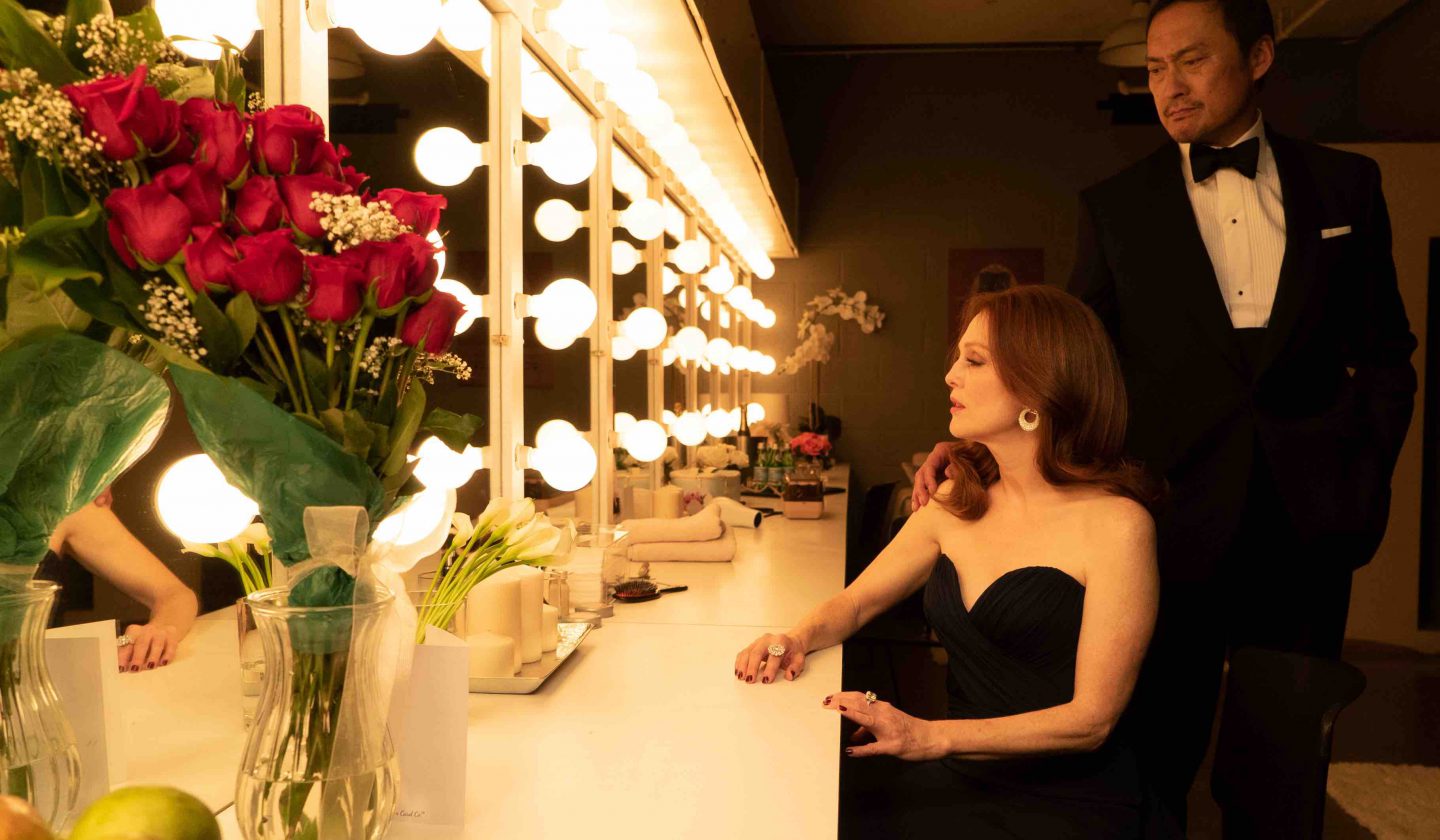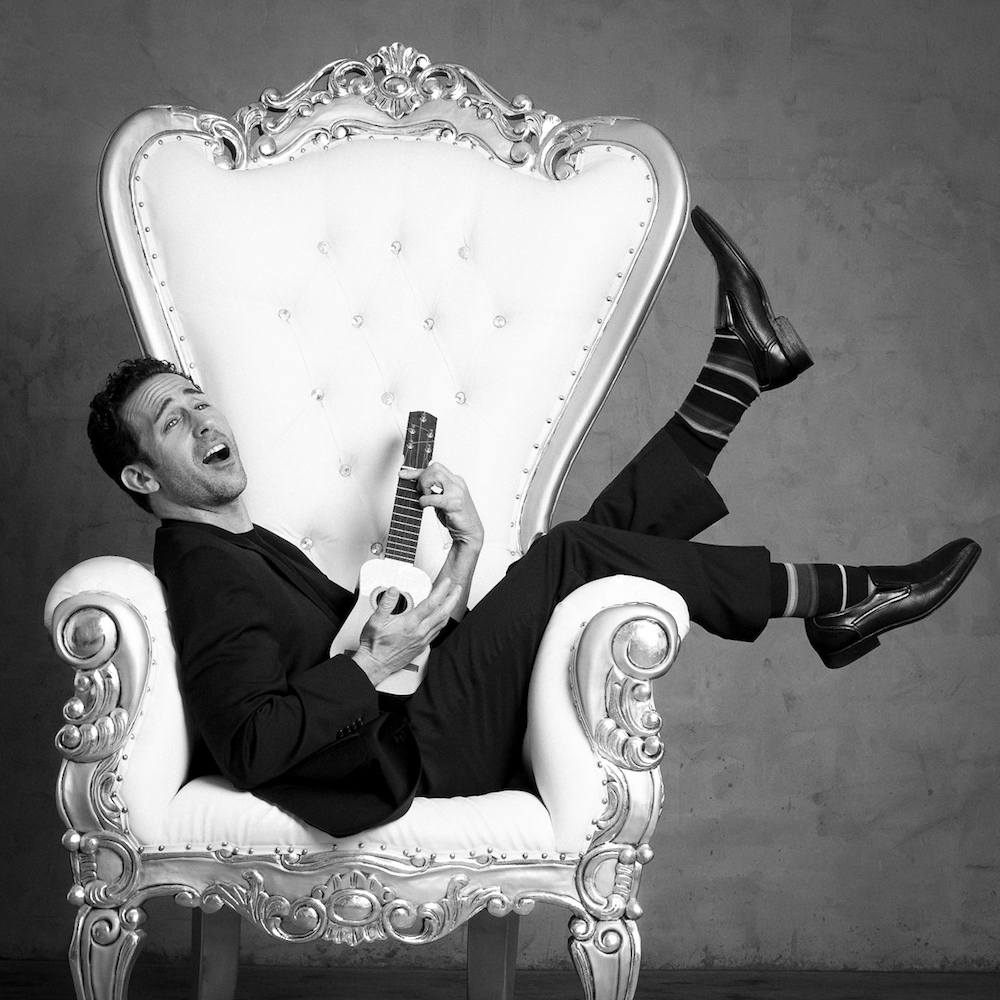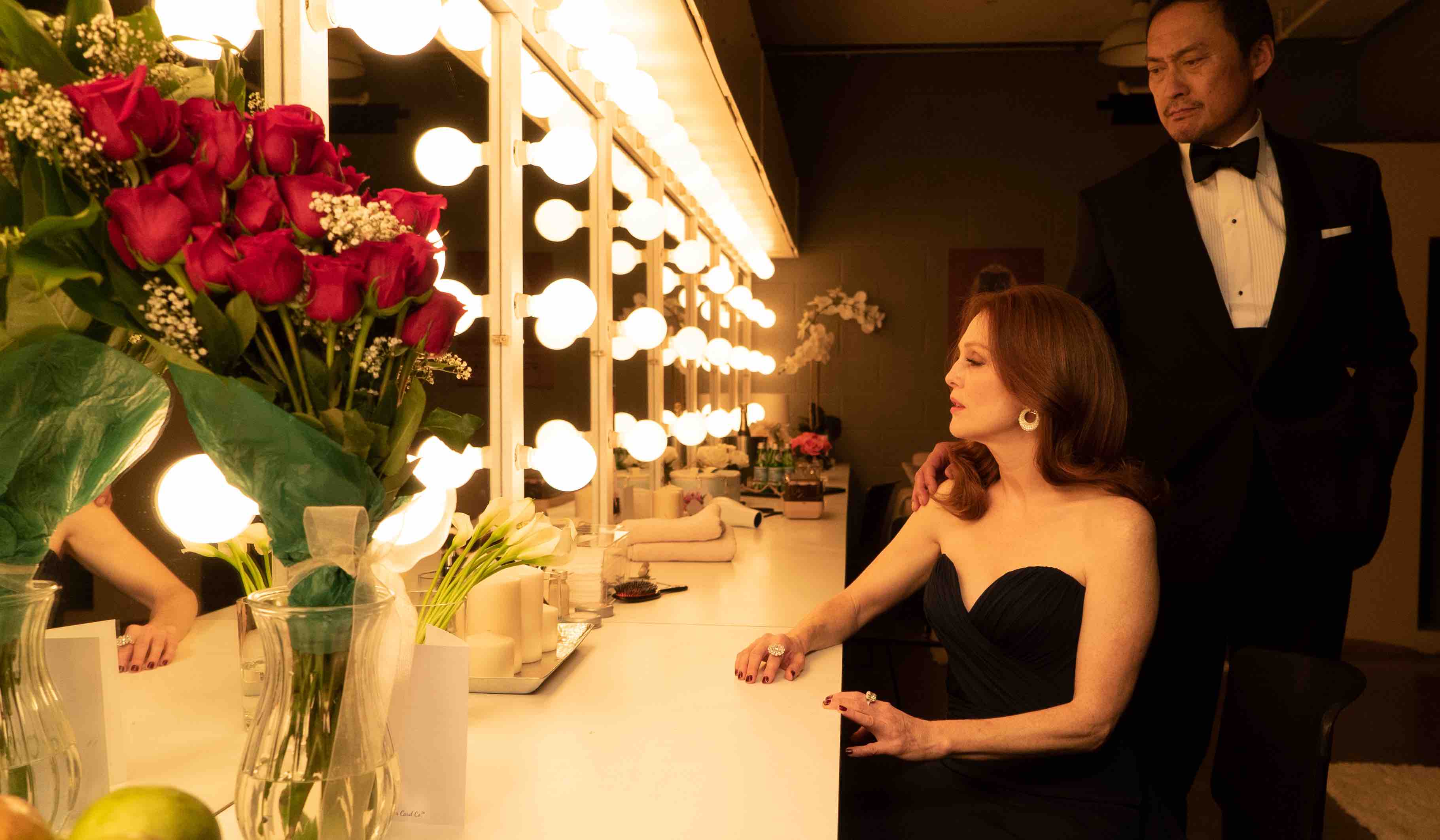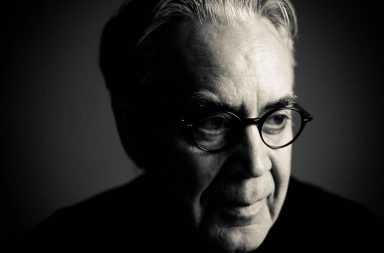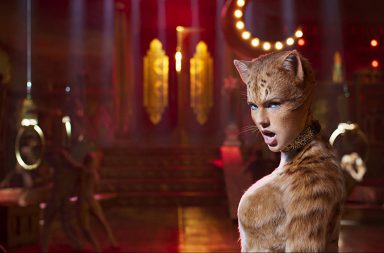An Emmy-nominated composer and music producer, David Majzlin is a prolific and surprising musician whose work can be heard in theatres (Manigma, starring Michael Aronov), on TV (he was commissioned by Amazon Prime to write additional pieces for Mozart in the Jungle) and in films (Deej, The Loving Story, Sins of my Father, among others). His latest composition for the big screen is for Paul Weitz‘s Bel Canto, based on Ann Patchett’s best-selling novel. The dramatic love story, set against the background of the political unrest of an unnamed South American country, gave David the opportunity to work with the five-time Grammy winner and opera star Renée Fleming. Julianne Moore plays Roxanne Coss, a famous soprano who ends up being a hostage of the guerrilleros, and Fleming lends her (singing) voice to the character. The renowned opera singer also collaborated with the composer on the score, singing vocalese and worked with him on the underscore of the film.
With passion and enthusiasm, David Majzlin took the time to chat with Score It Magazine about Bel Canto, Renée Fleming, classical music, his use of a Canarian instrument, the timple, and his musical journey.
Score It Magazine: Firstly, can you tell us about your formation as a musician and composer?
David Majzlin: My publishing company is called Toy Hammer Music, because when I was two years old I destroyed my parents’ piano (he smiles). It was a very nice piano with ivory keys, and I was playing with a toy hammer… So that was my foray into musical adventures, even though it was not exactly the way my parents would have wanted me to start. But, you know, I was definitely interested at a young age (laughs)! Then, I studied with all sorts of teachers, took piano lessons, all those things that make traditional music learning, but the one thing that for me was the most fun was playing with different ensembles and groups. The more people I met, the more I would try to absorb their style or understand what they were doing. I was in school at University of Florida, started off doing composition and then moved into film. I was playing a lot in bands. I did not necessarily enjoy the study of music as much as actually writing it and then going out and playing it. A lot of my undergraduate studies were spent playing and studying film. I did a program at NYU on film criticism, that was all about how to analyse film narrative and that helped me a lot with regard to scoring, because I realised that often, you never even talk about music on a film.
What kind of bands did you play in?
When I was in New York, while studying at NYU, there were all types of bands that were playing at these different showcases – EMJ showcases, SXSW showcases – and they were all great bands! I mean, all of them could be big, but for one reason or another, they all went their own way. I was the mercenary: I played bass, so I was always in the background, I was never part of any band, really, it was more about just playing. If I knew a good drummer, then it was a great package and they were like, “Oh my gosh, we need to have both of you.” So I was more of a gun for hire.
How did you meet Paul Weitz, and how were you brought to Bel Canto?
This project was brought to me by music supervisor Susan Jacobs, she and I have known each other for many, many years. She has been a wonderful supporter of my work, and she has a really amazing way of taking music and seeing a vision through a film. It’s rare that you get music supervisors that bring composers along with them; most of the time, music supervisors just clear the rights to a song, and that kind of things. But she’s really rare.
At the same time I was asked to consider Bel Canto. Mozart in the Jungle was happening, and Paul Weitz is the executive producer of that. The people from Mozart in the Jungle were calling to write pieces for the series while I was on Bel Canto, and I was also on a third project (laughs)! Paul was leaving for Japan, and so I sent him a lot of stuff, very fast. While he was going to Japan, I wrote music for Mozart in the Jungle, hoping I could do it before he would get off the plane (laughs) because it is both his projects! I didn’t say anything to him, I just kept going, and then, a few days later, he asked me, “How is Mozart in the Jungle? Should I be worried?” and I said, “Oh, no no no no, we’re all good!” He knew that we had two projects he asked me to score, so it got really crazy in the beginning, but it was great.
Opera singer Renée Fleming is the voice of Roxanne Coss, the character played by Julianne Moore. Was she an obvious choice?
What’s fun about this project is that it had to be Renée Fleming, because Ann Patchett, who is the author of the book Bel Canto on which the film is based, was inspired by Renée Fleming. While she was writing the book, she became friends with Renée Fleming and used her as a springboard to understand the world of opera. It is fun to see it go full circle, with the book becoming a film, and the natural choice had to be Renée because Ann and Renée were already corresponding at the time of the book. But even more than that, Renée is just spectacular. I mean, to work with someone like that, you are giving it to an incredible instrument with a specific, unique quality. It is so exciting to give someone like that notes on a page, because all of the notes are going to be interpreted by the player. I would give her directions, saying things that are not about music but about character. I would say, “The sound that I want is about a spirit, and the spirit is beautiful but it’s also haunting. It’s almost like the spirit of death.” And her voice was really wonderful for that, so that’s how that came about.
You invited Renée to sing on three of your compositions for the film. How different is it to work with her in this particular setting as opposed to when she sings preexisting arias?
It’s tremendously exciting! When you look at traditional works that are done in opera, they’ve been interpreted tens of thousands of time. That’s the beauty of music: singers interpret it, reinterpet it, interpret it, reinterpret it again, the way they think the composer wants it. And when the composer is no longer alive, it’s always interesting to see them sing the way they think the composer would have wanted. To have someone take your work that’s fresh and that no one’s ever recorded before is very exciting. Imagine being around at the time when Puccini or any other major figure wrote something and heard it for the first time… I wonder what they were thinking. But for me, the most fun in scoring films is when I first hear the interpretation. It doesn’t get better than that. Personally, I mark up my scores a lot, so I say, “This is what I’m going for,” but I try to make it very clear. It’s funny, because I taught a film scoring class at UCLA, and there was a student who always asked me, “Should we write ‘adagio?’ or any other specific terms?”. I mean, you can, but classical musicians have interpreted in such a way for so many years that they might come from different schools of teaching that may interpret those markings in a different way. So I said, “Just use clean speak.” Say “lightly”, or “like an angel”, or “breathe”… Something very common sense that you don’t have to overthink. So, with Renée, there was a lot of marking, but I gave her a lot of interpretation in terms of what vowels to use, so she had the ability to move. I would say things like, “somewhere between an “oh” and an “ah”,” so that her mouth could move in shape and morph, so it’s not always the same sound. This allows her to kind of move around the vowel a little bit, which I wanted to be mysterious and haunting and a little unsettling, but also quite beautiful and also very controlled. Because, if you think about, you know, the Grim Reaper, that’s the ultimate loss of control (laughs). He’s in control, really. Or she, in this case.
That’s funny, because it’s the main problem with the very technique of “Bel Canto.” No musician, no classical music specialist, over the last four hundred years, has figured out what bel canto is, actually. Whether it’s referring to a particular period in time, or a way to sing, or anything. It’s almost like, if you want to know what it is, just listen to different operas written by the representatives of bel canto and make up your own mind.
Exactly! And it was very important not to reference bel canto as a technique or as anything specific to that, because it’s more metaphorical. What was nice was when I got the call for a gig, and they asked me for my ideas. I hadn’t seen the film yet, they just described it to me. “What comes to your mind?,” which is always the scariest question, because for me, half of it is what’s in my head, but the other half is what’s on the screen. The visual language of a director is essential: the tone, the style. I mean, there’s a huge difference between a M. Night Shyamalan film and a Hitchcock film. One is going to borrow from the other, but they won’t have the same visual language that is going to indicate what the director might want. You’re going to see what the director is doing, what the editing is doing, what the colours are, the shades of the film… All these things are so integral. So, when I do a film and I don’t have a film but only the description of it, it’s fun on the one hand because you have total free reign, and on the other hand, it’s like, “Oh my gosh. Whatever I do, I hope that it matches.” In this case, the vocalise was the first piece that I wrote. So the pieces that you hear… Two of them were the first things that I wrote right off the top of my head. It was my first idea, raw. I tried to sing it myself, it was terrible, no one will hear those recordings (laughs), but that kind of idea was what I wanted. What was nice was when I worked on the film later, I learned that one of the pieces that they shot to was the Bachianas by Villa-Lobos, and that is in that style and I didn’t know that before! So I was like, “Oh, perfect, a few scenes into the film and we’re on the same page musically!” That was very exciting.
It is quite uncommon to hear the voice of an opera singer on original compositions with such Latin-American flavour.
Yes, it’s very specific. ‘Carmen’s Fantasy’ is a piece that has a lot of these shimmering trem-strings, it’s very lush. The scene the piece is set to, is, for me, the whole film in terms of the tone. What’s challenging about a film like this is, if you read the book, and then you read the script… well, it’s very well done! The book always lets you run off with the characters much more in depth. But when I looked at the film, it’s telling a story in a way that makes sense. What the film captures and what I was excited to see, because of that scene, is the magic behind music. How do you capture something that’s magical without any effect? That scene has one of the rebels who is a young innocent girl who joined this group because she came from a poor family and felt that fighting for their cause was the right thing to do. Her innocence is reflected in her style, in her look, in her acting – and I learned later that this girl was not a professional actor. So, in that scene, she tells Gen (editor’s note + spoiler alert: one of the hostages and her lover, played by Ryô Kase) that they are going to stay there, they are not leaving the house. Like, “We’re in love, let’s live here happily ever after.” That idea, to me, was so creepy. But just like her, we all want some magic in our lives, even though it’s entirely implausible. I love films like that! I love surreal ideas like that, Charlie Kaufman, Michel Gondry… These ideas where you’re dropped into a world you think is real, and without any special effects, you realize it’s not what it seems.
So, Renée is the spirit that moves through the house, and she’s almost what is hypnotizing this little girl. I have her sing these high staccato markings that are supposed to be an uncomfortable angel, so to speak. You’re not sure if you should be afraid of her or not. Then, I had her sing these legato passages that are about heart-opening, and that was very specific. The other aspect of that piece of music that plays prominently throughout the film, is this particular instrument called the timple. I had never heard of this before. I met this musician who was moving to Mexico, she was selling some instruments, that’s how I found my timple. They often call it timple canario, because it’s a typical instrument of the Canary Islands, but this one was made in Spain. It’s tuned like a ukulele: G-C-E-A-D. The C is an octave higher than it would be on a traditional ukulele, because it’s a classical guitar E-string, an iron string. When you play this instrument, it has such a beautiful, magical quality to it. And the reason I liked it so much, other than the beauty of it, was that in the film, we don’t reference any specific country. The book is loosely based on an event that happened at the Japanese embassy in Peru, but I didn’t want to make Peruvian music. With this, you’re not sure what you’re hearing. And then… I’m really a bass player, I play piano and guitar, but to play an instrument raw for the first time always takes some getting used to. In this case, due to the scheduling and due to the ideas that were coming out, all my first ideas were getting into the film (laughs). It was moving very quickly, and later, when I was preparing for orchestra, I thought, that those were my first takes, that I didn’t edit anything, and I panicked. But then I suddenly realised that that’s the whole point: the innocence of the playing, the non-perfection of it, the slight detuning… That’s what the character of Carmen is.
Do you know if Julianne Moore worked with Renée Fleming to mimic an opera singer?
I’m not the one to directly answer that, but I would imagine there was a lot of interaction. In the film, she’s lip-syncing to Renée. How was that executed? I don’t know, that was much earlier in the process.
How much amount of music did you write before seeing the first cut?
I probably submitted around ten pieces of music that I already had, just to see if anything I had in mind meant anything to anyone. When I taught my class, my class always asked, “How do you explain what you’re doing with the director?,” I said, “Don’t talk about music! Just talk about movies.” So, a lot of that is trying to figure out what they are thinking. In addition to those pre-recorded pieces, I added about ten, maybe twelve sketches, all different ideas. Like, I took an old art song by Enrique Granados, ‘El mirar de la maja’ (‘The Gaze of the Beloved’) and I tried an orchestral version of it. I tried many different things, and one thing that I quickly learned was that minimalism was essential. First of all, because you’re dealing with Renée Fleming who is a massive icon and she has her own sound; then, you have Julianne Moore who is a massive icon and she has her own thing, so you don’t want to step over anybody. You want to be able to allow those artists to shine, and I’m just the glue that’s connecting the walls. That was very important when I submitted the demos, and I didn’t know if Renée was going to sing on my score. I knew that she was doing the arias but I didn’t know if she would be available, so that was a big risk too, because… You want to be able to use Renée.
In the film, Roxanne/Renée sings excerpts from Puccini and Dvorak. She sings in Czech, which is quite an unusual language for an opera. How were these pieces chosen?
You would more specifically talk to Elena Park, she was one of the music producer involved with the arias. Now, the Dvorak piece is the one that Renée Fleming made famous. It’s the first piece that won, I guess, the Met auditions, but she made it famous early on in her career. It also goes on with the theme of the film, there’s such a haunting beauty to that work, it’s just astounding to hear that.
Opera is a genre that is usually considered for the elite, whereas in Bel Canto, it is a tool that binds all those characters together, rebels and hostages, poor and rich, teachers and billionaires.
Oh, yes. It stood out to me that the film itself is based on the dichotomies: you have all those dichotomies of rich against poor. This is a never-ending struggle, especially today, you can find all sorts of relevance with a film like this, like, you know, when things get desperate, you resort to desperate means. And so, from that aspect, those dichotomies happen throughout the film and I love this idea, you know, taking all these powerful, wealthy people and bring them down to the level of reality that the captors deal with every day, which is life, death, and survival, while rich people sip their cocktails. That’s fantastic. Now, in terms of how I approached this idea with music, the idea of listening is very important to me. Music is probably the only thing where you can have two conversations at the same time. Like, if you and I are talking at the same time, we will never be able to understand each other, but if we have a melody and a counter-melody, we can make them exist at the same time. In the film, there are several places where I tried to be very minimal when there really is a need to hear what’s going on from someone who has suffered. If I get too musical, it can reduce the severity of what this person is saying or it can make it trivial. These people are coming from an environment that we don’t even need to go into to understand them: they have guns, they are taking over, they are really young… It was very important for me, to try to have places where I just let the characters speak.
Compositionally, I didn’t want to get overly complex with anything; firstly because you only have a certain time when you are working on a film, but also because I wanted to keep things moving without getting high-browed in terms of score. If it became this very involved score, if I scored it like it’s an opera, it would work against it.
There is a whole new generation of composers today that would agree with what you just said, but at the same time, those same composers are slowly turning their backs to classical scores, or even orchestral scores.
Well, the thing is, the world of classical music is very broad, so a lot of my classical musician friends hate the term “classical,” they’re like, “It’s referring to a time period of music!” (laughs). But I understand what they mean. I do believe I feel like this is always a debate. The most important thing to any film is that the score is helping to tell the story, right? No matter what it is. I love Paul Cantelon’s score for The Diving Bell and the Butterfly; it’s just piano, but it’s so beautiful and it works. Now, there is a lot of balance that has to happen in any film – the budget, tax implications, all those things that can go into whether you can have a live scoring session or not. For me, I always have to have live in there, something has to be live no matter what, because I have to have breath, I need something that is not perfect. But it is really about feeling, what you are doing live is needed to achieve the emotional effect that you want. If you’re replicating the same patches that you did in the studio, I don’t see much point to that.
I don’t think there’s the end of any movement now… I like this term “neo-classical”, I see it around a lot. For me, neo-classical is writing in a way that is for an ensemble, or that implicate the presence of an ensemble, whether it’s four DJs, fifty players or someone playing cans and someone playing a saw. Whatever it is, the idea is to think not in the computer, but to think it as an ensemble. If you are in the world of the computer, think of the ensemble in that specific world instead of thinking of tracks. What I think happens with sampling and faking things is people think in terms of tracks and what the sample is, like, “Is that harp?” Yes it is, but who cares! But if the emotion is coming through, I don’t care where the sample is from.
The other thing we have to be careful of is writing for the samples, because when you’re demoing, you want to put your best foot forward and sometimes, if you wanted to sound real, the only way to do that is to do whatever the samples do the best. In that case, that’s when you get these long passages, what musicians jokingly refer to as footballing, when you have all these notes so they look like a bunch of footballs. And that footballing comes from making these beautiful notes at home and they sound great, and when you present them, the director goes, “That’s amazing!” Most of the time, I would bring in musicians and say, “I need you to do this demo,” pay them for a short session where I’m just getting one idea, so that the director can hear the difference between a cello playing something in ten minutes and me tweaking it for four days. It’s essential. I do a lot of scores where I take people in, we play a lot of textural things, with cellos, playing above the bridge. I say that to my class all the time, and I try to get them excited about that because everyone has the same samples. Everyone. As for indie films, I don’t know, I mean… Indie films are in this position where they inherently always have to think more creatively. For example, I love what Danny Bensi does, that composer is fantastic! And he’s keeping it really simple, that’s smart.
Before the release of the film, Bel Canto was already adapted into an opera. Were you aware of that at the time when you scored the film? Did you draw any inspiration from it?
No, I was not! It was great, because I knew nothing about that and someone told me, “You know about the opera?” And I was like, “Wait, what op… Oh!” (laughs). I think I had heard about it somewhere because it was a big deal, but I knew nothing about it. But now I want to see it, for sure.
Can you say a few words about the upcoming talk you will give about Bel Canto, along with Renée Fleming, music producer Elena Park and screenwriter Anthony Weintraub, at the Guggenheim?
It’s going to be more of a Q&A, and there is also going to be a performance from the string quartet and a soprano that will be announced soon. I don’t know who it is, but Elena does. Elena is fantastic, she did all the Met HD productions and she does a lot of curating at National Sawdust, which is a great performance place in Brooklyn. Elena and Renée have known each other for many, many years, so when Renée and Ann were working together for the book, Elena already knew about that. And then, Anthony is a great writer, we also worked on Mozart in the Jungle, and I’m very excited to do this Q&A with him as well.
What about your next projects?
I am working on an opera, that’s gonna take a while! I’ve been writing music for this for many years now, it’s a project that has always been in the background. Right now, I’m looking for a Spanish librettist, because it takes place in Spain. And I’m working on a number of pieces for the voice with different singers, which is something I’m very excited for!
***
Bel Canto is released in the US on September 14, 2018.
Soundtrack release on Decca Records coming September 2018.
Talk at the Guggenheim on September 16, 2018, 7:30-8:50 pm: Bel Canto: Inside the Music with Renée Fleming, David Majzlin, Anthony Weintraub, and Elena Park, buy tickets here.
***
Interview prepared, conducted and transcribed by Valentin Maniglia. Edited by Marine Wong Kwok Chuen.
